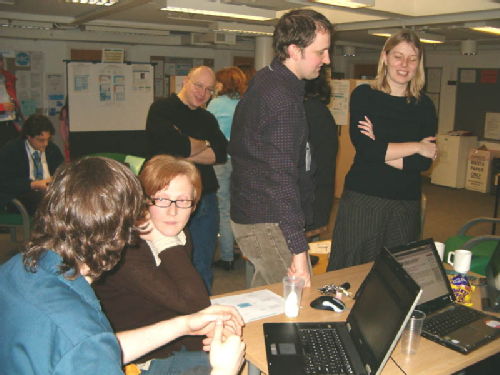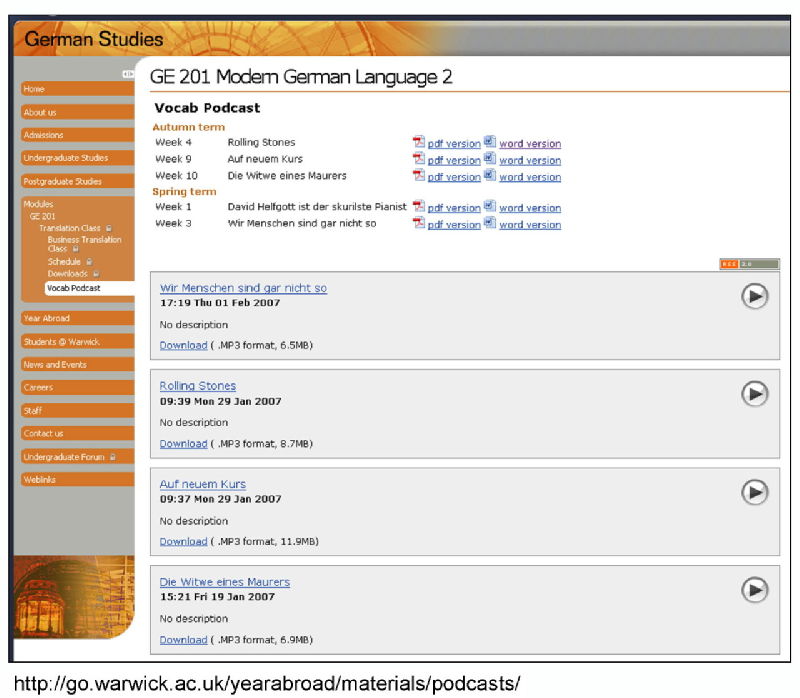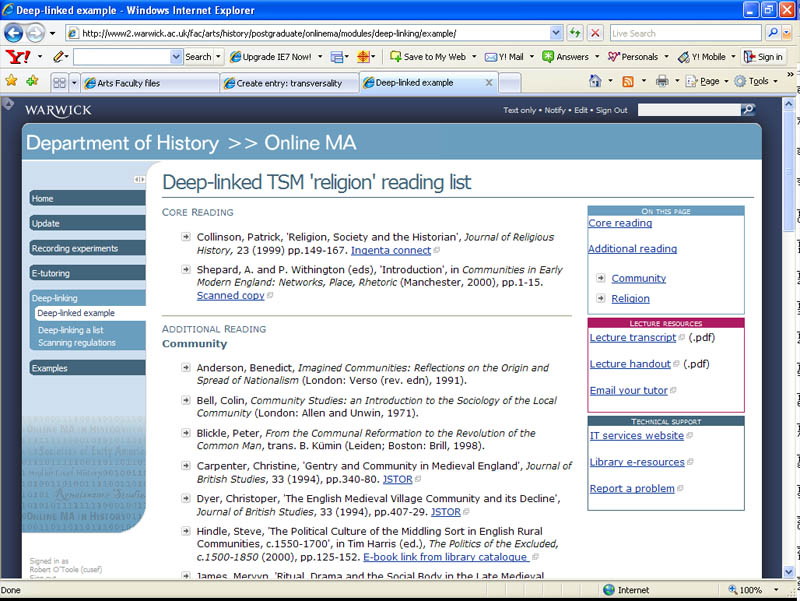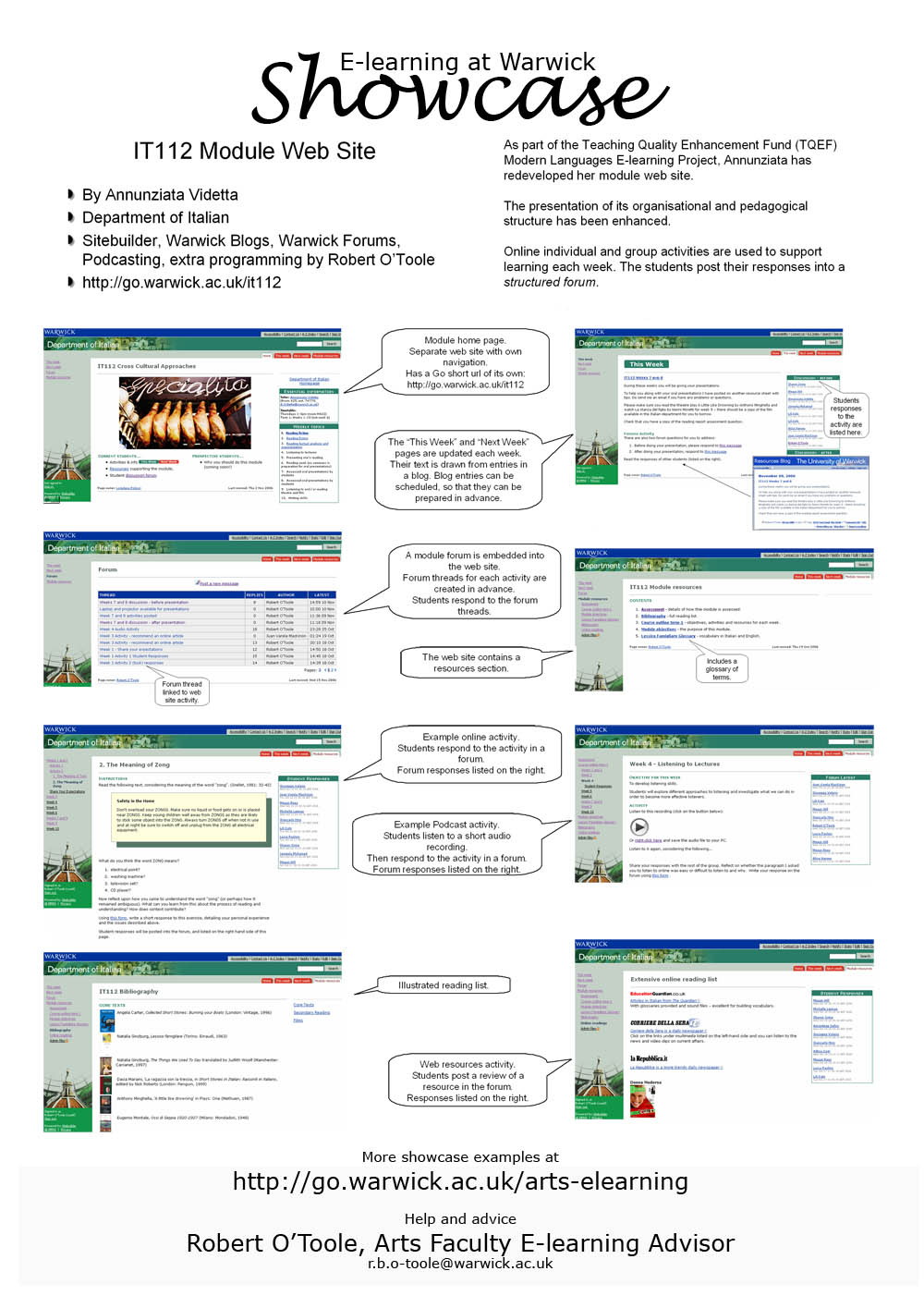All 8 entries tagged Arts Faculty Exhibitions
View all 9 entries tagged Arts Faculty Exhibitions on Warwick Blogs | View entries tagged Arts Faculty Exhibitions at Technorati | There are no images tagged Arts Faculty Exhibitions on this blog
February 20, 2007
A successful Arts Faculty E–learning Exhibition
Follow-up to Second Arts Faculty E–learning Exhibition Lunch from Transversality - Robert O'Toole

The exhibition was well attended. The poster display showcased more real examples of work from within the faculty, addressing the theme of “Supporting Students at a Distance”, with a consideration of these four issues:
- keeping students and tutors focussed;
- keeping people connected (community and communications);
- developing roles, responsibilities and identities, making them appropriate and well understood;
- supporting research, creativity and enterprise.
Technical demonstrations from Elab and the Library again proved popular, and Matt Jones from the Sitebuilder support team gave advice and guidance to a range of people.
The next event will be:
Arts Faculty E-coffee drop in
Wednesday 28th February, 2:30pm – 4:30pm, Graduate Space
February 07, 2007
Showcase: Podcast audio with Sitebuilder 2
Here is a screenshot from one of the examples used. It shows a series of podcasts that support vocab learning in German Studies:

Here is the text of the poster:
Why podcast? – It’s a flashy name for a simple technique. Record audio into an MP3 recorder (a kind of digital equivalent of a dictaphone), upload it to the web, allow other people to play the audio either in your web page, or downloaded onto their MP3 player (e.g. iPod).
Very little or no editing is required.
The MP3 recorder automatically creates the audio files (PC, Mac, Linux).
Both Sitebuilder 2 and Warwick Blogs include podcast players that do the rest of the work for you.
Why podcast? – There are many good reasons to record and share audio, both in “traditional” courses and “distance online” courses. For example:
- Record a brief introduction or summary to a lecture;
- Record a seminar or a presentation to use in formative or summative assessment;
- Present interviews with experts and academics;
- Create an archive of your lectures, so that you can re-use them in the future.
Get your students podcasting: Students can learn a lot from producing their own audio productions. For example, get your students to interview an expert on some topic. This will improve their questioning and investigation skills, along with IT and communications skills.
February 06, 2007
Showcase: Deep linking to library resources
Follow-up to Second Arts Faculty E–learning Exhibition Lunch from Transversality - Robert O'Toole
The showcase is based around the demo deep-linked reading list created by Madeline McKerchar (now of Cambridge University) for the Online MA in History.

The text of the poster reads as follows:
The University of Warwick Library offers an extensive range of online electronic resources, including books and journals. These resources can be accessed by students over the internet anywhere in the world at any time. You can easily build a Sitebuilder 2 page containing a list of links directly to these resources. Such direct connections are called “deep links”.
It is important to remember that many of these resources are provided by external organisations. To ensure that the web addresses that you provide stay operational over time, you should use the linking facilities provided by the Library. For example, the Build-a-Link tool can be used to generate stable urls (demo on the poster). Talk to your subject librarian for more details and guidance.
The poster gives the following useful links:
And the poster can be downloaded as a PDF from this page (login required).
February 02, 2007
Warwick Learning Environment features and your chance to tell us what you think
Follow-up to Announcement: Second Arts Faculty E–learning Exhibition Lunch, 9th February from Transversality - Robert O'Toole
Here is the Sitebuilder 2 node:

No doubt there are features that I have missed, as well as features that people would like to see added. As a means of capturing these extra features, I have printed the map out on A0 paper. I will display the map at the E-learning Exhibition. It will be accompanied by three sets of post it note pads. The yellow set can be used to add features to the map that I have forgotten about. The green set is for giving us feedback on current features. The pink set can be used to add suggestions of new features. All participants at the exhibition will be invited to add notes to the map.
Warwick members can download the concept map (MindManager required).
Or see the map as a PDF file.
January 30, 2007
Announcement: Second Arts Faculty E–learning Exhibition Lunch, 9th February
Follow-up to Second Arts Faculty E–learning Exhibition Lunch from Transversality - Robert O'Toole
Second Arts Faculty E-learning Exhibition Lunch, 9th February
The second Arts Faculty e-learning lunch exhibition will be held on Friday 9th February between 12:30 and 14:30 in the Graduate Space, 4th Floor Humanities (having been postponed by a week). As before, the format will be informal, with showcase posters, demonstrations on request, hardware to try out, and experts to advise you. Please feel free to pass this invite on to others, all are welcome (but it will help if you could send an email to artsfaculty@warwick.ac.uk so that we can estimate numbers)
Even in the short time since the last exhibition, many new features and tools have become available (such as Sitebuilder page personalisation, Files.Warwick file-sharing and storage, Sitebuilder term planner calendars). Our impressive set of examples of successful e-learning work has also grown significantly, with several new showcase presentations to view. If you did come to the last exhibition, there are many good reasons to come back for more (including the excellent food).
The theme of this second exhibition is “supporting students at a distance”. We will look at how technology can be used to enhance teaching and learning whenever students are situated remotely (some would argue that students are quite often at a distance). We hope to demonstrate that these techniques are useful in all teaching contexts. If you would like to contribute to this with your own examples, then contact me for details.
The exhibition will deal with this theme by addressing four common problems:
1. keeping students and tutors focussed;
2. keeping people connected (community and communications);
3. developing roles, responsibilities and identities, making them appropriate and well understood;
4. supporting research, creativity and enterprise.
Experts will be available to provide support, including:
- Jenny Delasalle, from the Library Innovations Unit (Build-a-Link deep linking, bibliographies, online book and journal scanning project);
- Richard Parker, head of Library Arts Team (Warwick History of Arts Skills Programme, Refworks, JSTOR, Arts resources);
- a representative of the Elab Sitebuilder team;
- Robert O’Toole, Arts Faculty E-learning Advisor;
- Steven Carpenter, Sciences E-learning Advisor (video and audio expert);
- Chris Coe, Social Studies E-learning Advisor;
- a representative from the Learning Grid;
- representatives from the Centre for Student Development and Enterprise (skills Recipe Cards, Warwick Skills Programme, Graduate School, ePortfolios).
Other items at the exhibition will include:
- details of new features in Sitebuilder and Warwick Blogs;
- a map of e-learning activities in the Arts Faculty;
- leaflets from Elab, IT Services, CSDE, the Library etc;
- a suggestions board, to feedback to Elab and the Library;
- an opportunity to arrange training sessions for your department.
Showcase poster design for e–learning exhibitions
Each poster demonstrates an example of the effective use of technology in teaching, learning and research. It has four elements:
- A series of statements about what it demonstates, who did the work, what technologies and techniques it employed, along with a url to the showcased work.
- A few short paragraphs of text (100 words maximum) explaining the rationale behind the showcase.
- A series of annotated screenshots or photographs demonstrating and explaining what has been done (a maximum of 8 on an A2 poster).
- A footer containing a link to the Arts E-learning web site and details of the E-learning Advisor.
The posters are printed to A2 (we have a colour A2 printer). My method for producing them is slightly odd. I first create each text element or image within a Powerpoint presentation, and then copy them into a Photoshop file (set to A2 size). I end up with a poster and a Powerpoint show for each showcase.
Here’s a good example:

If that’s too blurry on your screen, have a look at this it112_poster_small.pdf
For the next series of posters I am going to try to include more information about the processes and support infrastructure used to meet the stated objectives of each showcase.
January 26, 2007
4 essential goals in learning design
Follow-up to Second Arts Faculty E–learning Exhibition Lunch from Transversality - Robert O'Toole
Four problems (or challenges) are obvious. As Sarah Richardson of the History Online MA argues, these are in fact the same challenges that must be addressed by learning design in all higher education contexts (on site and distance). The challenges are:
- keeping students and the tutors focussed;
- keeping people connected (community) – communications and relations between tutors, tutors and students, students and their peers, as well as connections between the students and their departmental, faculty, subject and university communities;
- developing roles, responsibilities and identities, making them appropriate and well understood;
- supporting research, creativity and enterprise (for a definition of what I mean by this, see this article on research based learning).
With these challenges as the basis of the exhibition, my next task is to find showcase examples that demonstrate how our learning technologies support students and tutors in meeting these challenges. For example, I will show how a Sitebuilder term view calendar can be used to help define and keep course members effectively focussed.

January 23, 2007
Second Arts Faculty E–learning Exhibition Lunch
This second exhibition in the series will showcase a wide range of successful applications of technology in teaching, along with demonstrations of new hardware and software. Special exhibits will focus in particular upon the topic of:
Supporting students at a distance (more information below).
The exhibition is open to all staff and teaching postgraduate students within the Arts, as well as anyone else from across the University with an interest or expertise in this topic. It is an informal session, so please drop by at any time during the exhibition. A buffet lunch and drinks will be provided.
Supporting students at a distance
Students at Warwick are frequently expected to undertake work in a location away from the University campus and in less frequent contact with teaching staff and peers. This is not only true of fully distance based courses, but also of the research oriented student undertaking a project out in the field or writing a thesis. Some common examples are:
- full distance learning courses;
- hybrid distance and on-site courses;
- transnational courses;
- year abroad students;
- placement students;
- students in low-contact phases of a course (e.g. writing-up).
Many problems are posed by these arrangements, both to the student and to the tutor, but also to the administrator. Difficulties commonly occur in areas such as:
- establishing and relating to a peer group;
- connecting with the department and faculty community;
- connecting with the wider academic community;
- access to resources;
- understanding (and confirming) module or activity purpose;
- individual study guidance;
- discussing work;
- presenting work;
- submitting work.
Of course these problems may occur in any mode of study, including on-site high-contact courses. The techniques and technologies that have evolved to address these problems are therefore useful in many situations.
Warwick has developed a range of sophisticated but easy to use technologies that allow us to effectively address these problems. The E-learning Exhibition will demonstrate these technologies and techniques, with showcase examples of real solutions by people at Warwick.
We will show how tools including Sitebuilder, Warwick Forums, Warwick Blogs and Perception can be applied to create a learning environment customised to your particular mode of teaching and course delivery, whether at a distance or in close proximity.
 Robert O'Toole
Robert O'Toole

 Please wait - comments are loading
Please wait - comments are loading